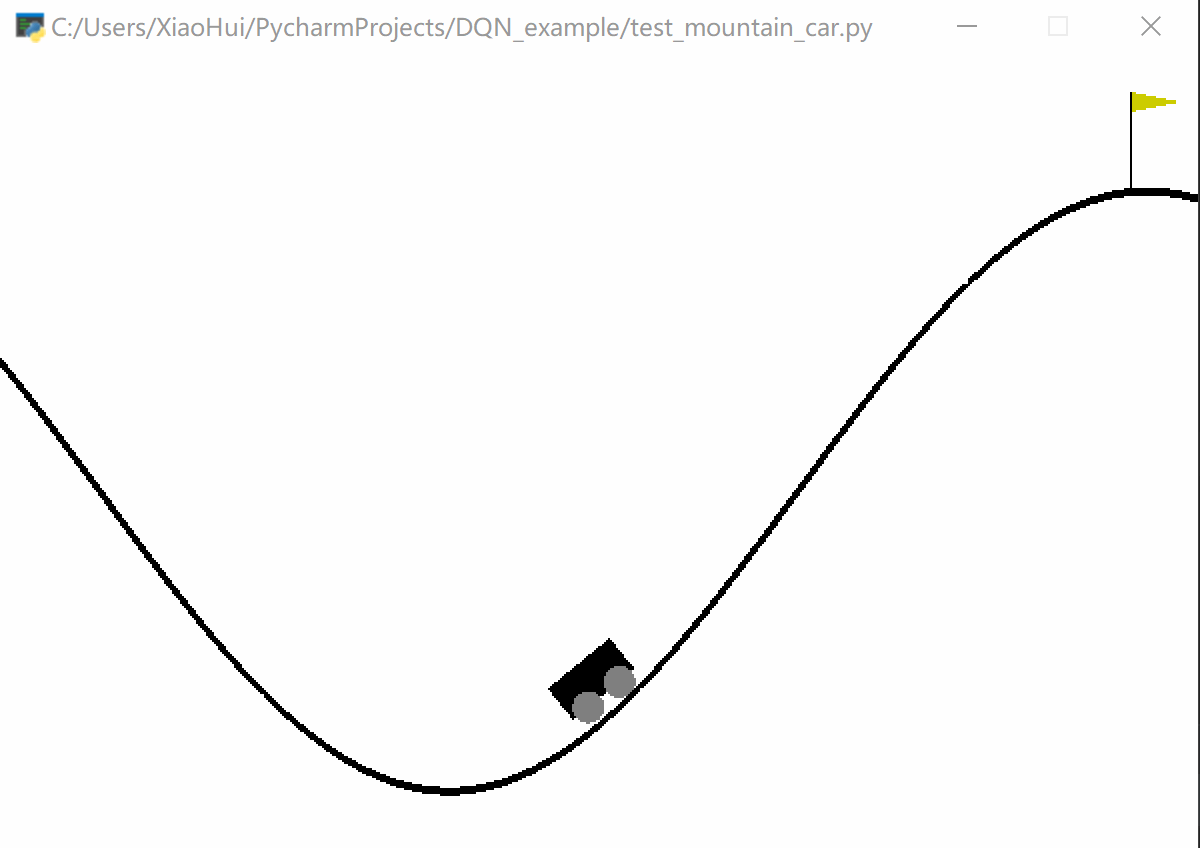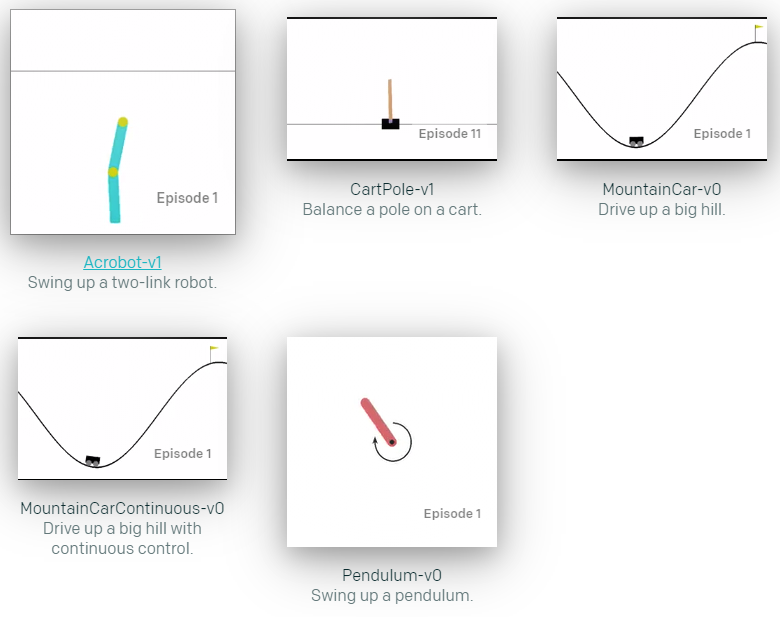DQN(Deep Q-learning)入门教程(六)之DQN Play Flappy-bird ,MountainCar
在DQN(Deep Q-learning)入门教程(四)之Q-learning Play Flappy Bird中,我们使用q-learning算法去对Flappy Bird进行强化学习,而在这篇博客中我们将使用神经网络模型来代替Q-table,关于DQN的介绍,可以参考我前一篇博客:DQN(Deep Q-learning)入门教程(五)之DQN介绍
在这篇博客中将使用DQN做如下操作:
- Flappy Bird
- MountainCar-v0
再回顾一下DQN的算法流程:

项目地址:Github
MountainCar-v0
MountainCar的训练好的Gif示意图如下所示,汽车起始位置位于山的底部,最终目标是驶向右边山的插旗的地方,其中,汽车的引擎不能够直接驶向终点,必须借助左边的山体的重力加速度才能够驶向终点。

MountainCar-v0由OpenAI提供,python包为gym,官网网站为https://gym.openai.com/envs/MountainCar-v0/。在Gym包中,提供了很多可以用于强化学习的环境(env):

在MountainCar-v0中,状态有2个变量,car position(汽车的位置),car vel(汽车的速度),action一共有3种: Accelerate to the Left, Don't accelerate,Accelerate to the Right,然后当车达到旗帜的地方(position = 0.5)会得到\(reward = 1\)的奖励,如果没有达到则为\(-1\)。但是如果当你运行步骤超过200次的时候,游戏就会结束。详情可以参考源代码(ps:官方文档中没有这些说明)。
下面介绍一下gym中几个常用的函数:
-
env = gym.make("MountainCar-v0")这个就是创建一个
MountainCar-v0的游戏环境。 -
state = env.reset()重置环境,返回重置后的state
-
env.render()将运行画面展示在屏幕上面,当我们在训练的时候可以不使用这个来提升速度。
-
next_state, reward, done, _ = env.step(action)执行action动作,返回下一个状态,奖励,是否完成,info。
初始化Agent
初始化Agent直接使用代码说明吧,这个还是比较简单的:
import keras
import random
from collections import deque
import gym
import numpy as np
from keras.layers import Dense
from keras.models import Sequential
class Agent():
def __init__(self, action_set, observation_space):
"""
初始化
:param action_set: 动作集合
:param observation_space: 环境属性,我们需要使用它得到state的shape
"""
# 奖励衰减
self.gamma = 1.0
# 从经验池中取出数据的数量
self.batch_size = 50
# 经验池
self.memory = deque(maxlen=2000000)
# 探索率
self.greedy = 1.0
# 动作集合
self.action_set = action_set
# 环境的属性
self.observation_space = observation_space
# 神经网路模型
self.model = self.init_netWork()
def init_netWork(self):
"""
构建模型
:return: 模型
"""
model = Sequential()
# self.observation_space.shape[0],state的变量的数量
model.add(Dense(64 * 4, activation="tanh", input_dim=self.observation_space.shape[0]))
model.add(Dense(64 * 4, activation="tanh"))
# self.action_set.n 动作的数量
model.add(Dense(self.action_set.n, activation="linear"))
model.compile(loss=keras.losses.mean_squared_error,
optimizer=keras.optimizers.RMSprop(lr=0.001))
return model
我们使用队列来保存经验,这样的话新的数据就会覆盖远古的数据。此时我们定义一个函数,专门用来将数据保存到经验池中,然后定义一个函数用来更新\(\epsilon\)探索率。
def add_memory(self, sample):
self.memory.append(sample)
def update_greedy(self):
# 小于最小探索率的时候就不进行更新了。
if self.greedy > 0.01:
self.greedy *= 0.995
训练模型
首先先看代码:
def train_model(self):
# 从经验池中随机选择部分数据
train_sample = random.sample(self.memory, k=self.batch_size)
train_states = []
next_states = []
for sample in train_sample:
cur_state, action, r, next_state, done = sample
next_states.append(next_state)
train_states.append(cur_state)
# 转成np数组
next_states = np.array(next_states)
train_states = np.array(train_states)
# 得到next_state的q值
next_states_q = self.model.predict(next_states)
# 得到state的预测值
state_q = self.model.predict_on_batch(train_states)
# 计算Q现实
for index, sample in enumerate(train_sample):
cur_state, action, r, next_state, done = sample
if not done:
state_q[index][action] = r + self.gamma * np.max(next_states_q[index])
else:
state_q[index][action] = r
self.model.train_on_batch(train_states, state_q)
大家肯定从上面的代码发现一些问题,使用了两个for循环,why?首先先说一下两个for循环分别的作用:
- 第一个for循环:得到
train_states和next_states,其中next_states是为了计算Q现实。 - 第二个for循环:计算Q现实
可能有人会有一个疑问,为什么我不写成一个for循环呢?实际上写成一个for循环是完全没有问题的,很🆗,但是写成一个for循环意味着我们要多次调用model.predict_on_batch,这样会耗费一定的时间(亲身试验过,这样会比较慢),因此,我们写成了两个for循环,然后只需要调用一次predict
执行动作与选择最佳动作
执行动作的代码如下所示:
def act(self, env, action):
"""
执行动作
:param env: 执行环境
:param action: 执行的动作
:return: ext_state, reward, done
"""
next_state, reward, done, _ = env.step(action)
if done:
if reward < 0:
reward = -100
else:
reward = 10
else:
if next_state[0] >= 0.4:
reward += 1
return next_state, reward, done
其中,我们可以修改奖励以加快网络收敛。
选择最好的动作的动作如下所示,会以一定的探索率随机选择动作。
def get_best_action(self, state):
if random.random() < self.greedy:
return self.action_set.sample()
else:
return np.argmax(self.model.predict(state.reshape(-1, 2)))
开始训练
关于具体的解释,在注释中已经详细的说明了:
if __name__ == "__main__":
# 训练次数
episodes = 10000
# 实例化游戏环境
env = gym.make("MountainCar-v0")
# 实例化Agent
agent = Agent(env.action_space, env.observation_space)
# 游戏中动作执行的次数(最大为200)
counts = deque(maxlen=10)
for episode in range(episodes):
count = 0
# 重置游戏
state = env.reset()
# 刚开始不立即更新探索率
if episode >= 5:
agent.update_greedy()
while True:
count += 1
# 获得最佳动作
action = agent.get_best_action(state)
next_state, reward, done = agent.act(env, action)
agent.add_memory((state, action, reward, next_state, done))
# 刚开始不立即训练模型,先填充经验池
if episode >= 5:
agent.train_model()
state = next_state
if done:
# 将执行的次数添加到counts中
counts.append(count)
print("在{}轮中,agent执行了{}次".format(episode + 1, count))
# 如果近10次,动作执行的平均次数少于160,则保存模型并退出
if len(counts) == 10 and np.mean(counts) < 160:
agent.model.save("car_model.h5")
exit(0)
break
训练一定的次数后,我们就可以得到模型了。然后进行测试。
模型测试
测试的代码没什么好说的,如下所示:
import gym
from keras.models import load_model
import numpy as np
model = load_model("car_model.h5")
env = gym.make("MountainCar-v0")
for i in range(100):
state = env.reset()
count = 0
while True:
env.render()
count += 1
action = np.argmax(model.predict(state.reshape(-1, 2)))
next_state, reward, done, _ = env.step(action)
state = next_state
if done:
print("游戏的次数:", count)
break
部分的结果如下:

Flappy Bird
FlappyBird的代码我就不过多赘述了,里面的一些函数介绍可以参照这个来看:DQN(Deep Q-learning)入门教程(四)之Q-learning Play Flappy Bird,代码思想与训练Mountain-Car基本是一致的。
import random
from collections import deque
import keras
import numpy as np
from keras.layers import Dense
from keras.models import Sequential
from ple import PLE
from ple.games import FlappyBird
class Agent():
def __init__(self, action_set):
self.gamma = 1
self.model = self.init_netWork()
self.batch_size = 128
self.memory = deque(maxlen=2000000)
self.greedy = 1
self.action_set = action_set
def get_state(self, state):
"""
提取游戏state中我们需要的数据
:param state: 游戏state
:return: 返回提取好的数据
"""
return_state = np.zeros((3,))
dist_to_pipe_horz = state["next_pipe_dist_to_player"]
dist_to_pipe_bottom = state["player_y"] - state["next_pipe_top_y"]
velocity = state['player_vel']
return_state[0] = dist_to_pipe_horz
return_state[1] = dist_to_pipe_bottom
return_state[2] = velocity
return return_state
def init_netWork(self):
"""
构建模型
:return:
"""
model = Sequential()
model.add(Dense(64 * 4, activation="tanh", input_shape=(3,)))
model.add(Dense(64 * 4, activation="tanh"))
model.add(Dense(2, activation="linear"))
model.compile(loss=keras.losses.mean_squared_error,
optimizer=keras.optimizers.RMSprop(lr=0.001))
return model
def train_model(self):
if len(self.memory) < 2500:
return
train_sample = random.sample(self.memory, k=self.batch_size)
train_states = []
next_states = []
for sample in train_sample:
cur_state, action, r, next_state, done = sample
next_states.append(next_state)
train_states.append(cur_state)
# 转成np数组
next_states = np.array(next_states)
train_states = np.array(train_states)
# 得到下一个state的q值
next_states_q = self.model.predict(next_states)
# 得到预测值
state_q = self.model.predict_on_batch(train_states)
for index, sample in enumerate(train_sample):
cur_state, action, r, next_state, done = sample
# 计算Q现实
if not done:
state_q[index][action] = r + self.gamma * np.max(next_states_q[index])
else:
state_q[index][action] = r
self.model.train_on_batch(train_states, state_q)
def add_memory(self, sample):
self.memory.append(sample)
def update_greedy(self):
if self.greedy > 0.01:
self.greedy *= 0.995
def get_best_action(self, state):
if random.random() < self.greedy:
return random.randint(0, 1)
else:
return np.argmax(self.model.predict(state.reshape(-1, 3)))
def act(self, p, action):
"""
执行动作
:param p: 通过p来向游戏发出动作命令
:param action: 动作
:return: 奖励
"""
r = p.act(self.action_set[action])
if r == 0:
r = 1
if r == 1:
r = 100
else:
r = -1000
return r
if __name__ == "__main__":
# 训练次数
episodes = 20000
# 实例化游戏对象
game = FlappyBird()
# 类似游戏的一个接口,可以为我们提供一些功能
p = PLE(game, fps=30, display_screen=False)
# 初始化
p.init()
# 实例化Agent,将动作集传进去
agent = Agent(p.getActionSet())
max_score = 0
scores = deque(maxlen=10)
for episode in range(episodes):
# 重置游戏
p.reset_game()
# 获得状态
state = agent.get_state(game.getGameState())
if episode > 150:
agent.update_greedy()
while True:
# 获得最佳动作
action = agent.get_best_action(state)
# 然后执行动作获得奖励
reward = agent.act(p, action)
# 获得执行动作之后的状态
next_state = agent.get_state(game.getGameState())
agent.add_memory((state, action, reward, next_state, p.game_over()))
agent.train_model()
state = next_state
if p.game_over():
# 获得当前分数
current_score = p.score()
max_score = max(max_score, current_score)
scores.append(current_score)
print('第%s次游戏,得分为: %s,最大得分为: %s' % (episode, current_score, max_score))
if len(scores) == 10 and np.mean(scores) > 150:
agent.model.save("bird_model.h5")
exit(0)
break
该部分相比较于Mountain-Car需要更长的时间,目前的我还没有训练出比较好的效果,截至写完这篇博客,最新的数据如下所示:

emm,我又不想让我的电脑一直开着,😔。
总结
上面的两个例子便是DQN最基本最基本的使用,我们还可以将上面的FlappyBird的问题稍微复杂化一点,比如说我们无法直接的知道环境的状态,我们则可以使用CNN网络去从游戏图片入手(关于这种做法,网络上有很多人写了相对应的博客)。
项目地址:Github




 浙公网安备 33010602011771号
浙公网安备 33010602011771号